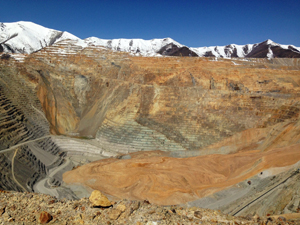Just over two weeks after a landslide sent 165 million tons of earth down into the world’s largest open-pit copper mines located west of Salt Lake City, covering portions of the floor up to 300 ft deep, mine officials will be allowed a closer look at the damage. The Mine Safety and Health Administration recently cleared geologists and engineers from Rio Tinto’s Kennecott Utah Copper to enter the massive slide area in the Bingham Canyon mine.

Kennecott spokesman Kyle Bennett says earlier, more distant, reviews of the mine floor showed that the in-pit crusher and five-mile conveyor, which moves crushed rock to the facility’s concentrator, were undamaged.
“We have had damage to three of our 13 shovels and 14 of our 100 hauling trucks,” Bennett says. “We don’t know yet whether any of them will be recoverable. We also have damage to a few of our graders and dozers that were in the pit. Some of the equipment has been buried by the slide and some has been damaged and moved out of the area.”
Cementation, a global mine-building contractor with U.S. operations based in nearby Sandy, Utah. was at work on two exploratory tunnels in the mine. Those have been covered by the slide, says Willie Finch, a Cementation spokesman. “The portals we had were at the bottom of the mine on the south wall, and they are now buried,” Finch says. “We had two bolters and two drillers there. We know where they are; we just can’t get to them. Our assumption is that equipment will be lost, but we are hopeful it will not be. I’m not sure of its value at this time.”
Finch says Kennecott has suspended Cementation’s contract and the company laid off its 70 people working at the site.
Mining operations continue on the unaffected upper southeast side of the pit, Bennett says. The company has also been using trucks to haul stockpiled material to the concentrator while regular operations are scaled back.
Kennecott President Kelly Sanders announced in an April 25 press conference a plan for returning the mine to productivity, albeit reduced from Rio Tinto’s original estimates. “In the next 30 days, we will complete an assessment of the pit to ensure safe work conditions and once those are satisfied, we’ll begin moving ore to the crusher again,” Sanders said. “As we resume operations, we expect that our production to be about 50% of what our plan for 2013 was.”
Bennett said the slide destroyed an access road into the pit and officials will be developing plans for reconstructing it as soon as possible.
The slide occurred April 10 on the mine’s northeast slope and was anticipated by Kennecott engineers. Days before it occurred, crews moved equipment away from the rim, along with the modular visitors center building. There were no injuries to mine personnel or the public.
Sanders says the company will be looking at ways to contain costs in the coming months, and that includes layoffs. Since the slide, the company has shifted workers to other parts of the operation and asked some to take voluntary time off.
The Bingham Canyon mine has operated for more than 100 years and is the second-largest copper mine in the United States. In addition to producing 300,000 tons of copper a year, the mine produces 400,000 ounces of gold; 4 million ounces of silver; 30 million lb of molybdenum; and 1 million tons of sulfuric acid annually.
Kennecott Utah Copper is a subsidiary of London-based Rio Tinto.


Post a comment to this article
Report Abusive Comment